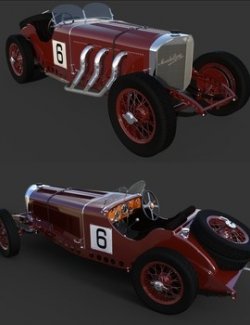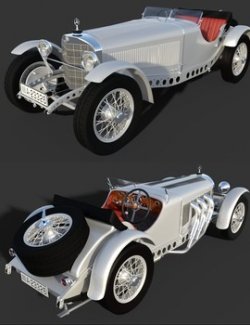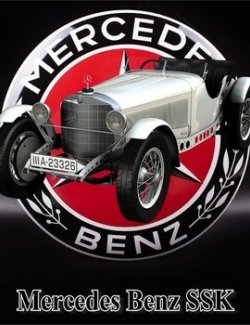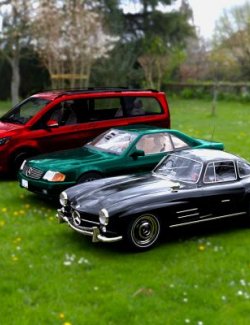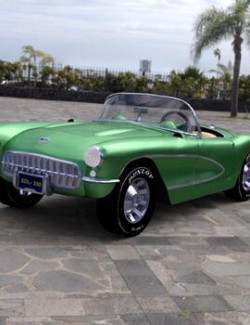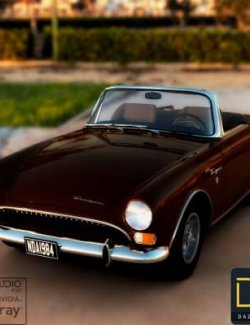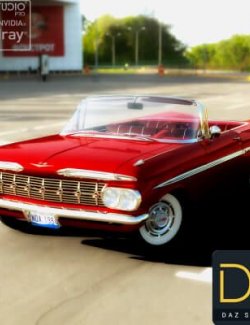The Mercedes-Benz 300 SL (chassis code W 198) is a two-seat sports car that was produced by Mercedes-Benz from 1954 to 1957 as a gullwinged coup and from 1957 to 1963 as a roadster. The 300 SL traces its origins to the company's 1952 racing car, the W194, and was equipped with a mechanical direct fuel injection system that significantly increased the power output of its three-liter overhead camshaft straight-six engine.
The 300 SL was capable of reaching speeds of up to 263 km/h (163 mph), earning it a reputation as a sports car racing champion and making it the fastest production car of its time. The car's iconic gullwing doors and innovative lightweight tubular-frame construction contributed to its status as a groundbreaking and highly influential automobile.
The designation "SL" is an abbreviation of the German term "super-leicht," meaning "super-light," a reference to the car's racing-bred lightweight construction. The 300 SL was introduced to the American market at the suggestion of Max Hoffman, Mercedes-Benz's United States importer at the time, who recognized the potential demand for a high-performance sports car among American buyers. The Mercedes-Benz 300 SL remains a highly sought-after classic car and is celebrated for its performance, design, and technological advancements.
Origin of the 300 SL
The idea of Mercedes producing a toned-down Grand Prix car targeted to affluent performance enthusiasts in the booming post-war American market was suggested by Max Hoffman at a 1953 directors' meeting in Stuttgart.Mercedes' new general director, Fritz Konecke, agreed to Hoffman's order for 1,000 cars to guarantee the success of the production run;the 300 SL was introduced at the February 1954 New York International Auto Show instead of the Frankfurt or Geneva shows, where company models usually debuted. In addition, the production of a smaller roadster, the Mercedes-Benz 190 SL, was announced after Hoffman ordered another 1,000 of them. The 300 SL and the 190 SL premiered at the 1954 New York show; Mercedes-Benz experienced a positive visitor response to both, and production began at the Sindelfingen plant in August of that year.
SL abbreviation
Mercedes-Benz did not announce what the abbreviation "SL" meant when the car was introduced; magazines and company officials have called it "Sport Leicht" and "Super Leicht" ("light"). It was called "Sport Leicht" on the company website until 2017, when "SL" was changed to "Super Leicht" after a chance finding in the corporate archives.
A special 300 SLS (Super Light Special) version of the 300 SL roadster was created for the Mercedes-Benz US racing team to compete on the Sports Car Club of America (SCCA) national circuit in 1957. After the 300 SL coupe dominated the D Production class en route to titles in 1955 and 1956, the rules were changed to make the class more competitive by enlarging the maximum engine size from three to 3.5 liters. Rather than radically modifying its engine size (on the cusp of releasing the company's new 300 SL roadster, replacing the coupe), Mercedes-Benz created two roadsters to campaign on the D Modified class SCAA circuit. They featured a solid cover over the passenger seat, a low-profile racing screen in place of a full-width and -height windscreen, a driver's seat roll bar, a custom cowl with engine air intake, and no front and rear bumpers. These and other modifications lowered vehicle weight from 1,420 kilograms (3,130 pounds) to 1,040 kilograms (2,290 pounds). Engine output was increased 20 hp (15 kW), to 235 hp (175 kW). Team driver Paul O'Shea again won the title for the company.
The 300 SL has a steel tubular frame chassis, with a steel body combined with an aluminum bonnet, doors, dashboard, and boot lid to further reduce weight. An additional 80 kilograms (176 pounds) could be eliminated with an expensive all-aluminum body, but only 29 were made. Depending on the rear axle ratio, fuel consumption was 17 liters per 100 km (14 miles per US gallon; 17 miles per imperial gallon).
Interior
Three checkered-pattern seat fabrics were standard: gray and green, gray and blue, and cream and red. Most customers opted for leather upholstery, which became standard on the roadster. With upward-opening doors, the coupe has an unusually-high sill; entering and exiting the car is problematic. The steering wheel pivots on its hub 90 degrees away from the dashboard to facilitate entry. Storage space for luggage is behind the seats in the coupe; the boot only holds a spare wheel and fuel tank. The roadster was available with two custom-fitted leather suitcases for the larger boot. The coupe's windows are fixed and roll down in the roadster.
Exterior
The body consists mainly of sheet steel, with the bonnet, boot lid, dashboard, sill, and door skins made of aluminum. Silver-gray was the standard color; all others were options.[17]
The objective of the overall design was to make the vehicle as streamlined as possible. The width of the tubular frame along the cockpit allowed the cabin roofline to be inset considerably on both sides, dramatically reducing the front area. The structure was also quite high between the wheels, prohibiting the attachment of standard doors. The only option already used on the W194 race car which would allow passengers over its high, deep sill was a gullwing door.
The car s distinctive eyebrows are a functional feature in the front, both physically and aerodynamically deflecting road water from the windscreen,and stylistic in the rear, added for visual symmetry.
Engine
The Mercedes-Benz M198 engine is a water-cooled 3.0 L, 182.8 cu in, 2,996 cc overhead cam straight six. Like the racing Mercedes-Benz M194, the 300 SL borrowed the basic two-valves-per-cylinder M186 engine from the regular four-door 300 (W186 "Adenauer") luxury touring car introduced in 1951.
It featured the M186's aluminum head: a 30-degree diagonal base, allowing larger intake and exhaust valves than a standard horizontal joint with the engine block. To improve performance, the M198 replaced the W194's triple two-barrel Solex carburetors with a Bosch mechanical fuel-injection system. This raised output on the 300 SL from 175 hp (130 kW; 177 PS) SAE gross to 240 hp (179 kW; 243 PS) SAE gross at 6,100 rpm. Compression was set at 8.55:1.
Another performance feature was dry sump lubrication, which ensured proper oil distribution in high-speed cornering and reduced engine height by eliminating a traditional oil pan. A more-powerful version of the M198, with a radical sports camshaft and 9.5:1 compression ratio, could be ordered free of additional charge for the coupe. The roadster had this engine only in its 1957 debut year. For the M198 engine to be installed in a low-profile car, it was tilted 50 degrees toward the driver's side. The result was aerodynamic efficiency and an enormous, sand-cast aluminum intake manifold as wide as the engine.
The engine was coupled by a single-disk dry clutch to a four-speed transmission with gear ratios of 3.34:1, 1.97:1, 1.39:1, and 1:1, and a reverse ratio of 2.73:1. The stock rear-axle ratio at the beginning of production was 1:3.42; at the 41st vehicle, it was changed to 1:3.64 for better acceleration. It allows a top speed of 235 km/h (146 mph) and acceleration from 0 to 100 km/h (62 mph) in 9.3 seconds. Faster acceleration was provided with ratios of 1:3.89 and 1:4.11. The lowest final-gear ratio, 1:3.25, delivered a top speed of up to 263 km/h (163 mph) and made the 300 SL the fastest production car of its time. City drivers found the tall first gear challenging. Clutch-pedal operation was initially cumbersome, remedied by an improved clutch-arm helper spring.
Unlike present-day electronic fuel-injection systems, the 300 SL's mechanical fuel pump would continue to inject gasoline into the engine during the interval between ignition shut-off and the engine's coming to a stop. This extra fuel washed away the oil film critical to an engine during start-up and led to oil dilution, excessive ring wear, and scouring of the cylinder walls. Exacerbating the problem was the engine's dry-sump lubrication system, with its large oil cooler and enormous 15 L (4.0 US gal) oil capacity, which virtually guaranteed that the oil would not get hot enough on the short trips frequently taken by most car owners to flow properly. Owners might block off airflow through the oil cooler and stick rigidly to the appropriately low 1,600 km (1,000 mi) recommended oil-change interval. An auxiliary fuel pump provided additional fuel for extended high-speed operation (or cold starts), but overuse could also lead to oil dilution.From March 1963 to the end of production later that year, a light alloy crankcase was installed in 209 vehicles.
Chassis
See caption
The 300 SL's tubular frame
Like modern racing cars, the 300 SL has a tubular frame, designed by Mercedes head engineer Rudolf Uhlenhaut and made of steel. Such a frame provided high rigidity with low mass. Thin, straight chrome-molybdenum tubes were assembled as triangles, with the finished frame weighing a remarkable 82 kilograms (181 pounds). Elements of the coupe frame fill span the entire width of the vehicle s track from wheel to wheel, making for an unusually high and deep threshold for access to the passenger compartment. The upper tube is so high it is level with the driver's elbow,[4] making conventional horizontally, hinged doors infeasible. The resulting design - upward opening gullwing doors - gave the car its iconic nickname.
The suspension was a regular Mercedes-Benz W186 with a sportier tuning. Front-to-rear weight distribution is almost exactly in the center of the vehicle.
Unlike many 1950s cars, recirculating ball steering was relatively precise, and the four-wheel independent suspension allowed for a reasonably-comfortable ride and markedly-better overall handling.
The front suspension consisted of unequal-length double wishbones, coil springs, hydraulic telescopic shock absorbers, and a torsion anti-roll bar.
The rear has a low-pivot swing axle, radius arms, and coil springs. Being jointed only at the differential (not at the wheels themselves), the swing axle could make rear end cornering treacherous at high speeds or on bad roads due to extreme changes in camber. This was remedied in the roadster by switching to a high-pivot geometry.
In mid-1956, sales had begun to fall, and the board decided to show a convertible version at the Geneva show in March and convert the factory to a roadster version in May 1957 to serve the California market.
The 300 SL Roadster, with conventional doors, was first exhibited at the Geneva Salon in May 1957. The production of an open 300 SL involved redesigning the cockpit with lower sills for improved access.The rear suspension also incorporated low-pivot swing axles.
The 1,420-kilogram (3,131-pound) roadster weighs 125 kilograms (276 pounds) more than the coupe; with 240 hp (179 kW), the roadster has slightly more power. Its tubular frame was modified to create more space in the boot. The spare tire was placed under the boot floor and, combined with a smaller fuel tank, made room for custom-made fitted luggage. The lower door sill provides a more comfortable entry.
The rear axle was changed to a single-joint arrangement, with its pivot point located 87 millimeters (3.4 in) below the differential centreline.This improved handling (particularly in corners) and comfort. Head engineer Uhlenhaut wanted the new low pivot axle for the coupe but was voted down by the board of directors, which reminded him that 3,000 manufactured axle units remained at the factory and costs were already high for the car. An optional hardtop became available in September 1958.
Mesh data
vertices: 134.496
tri ngulos: 186.596

